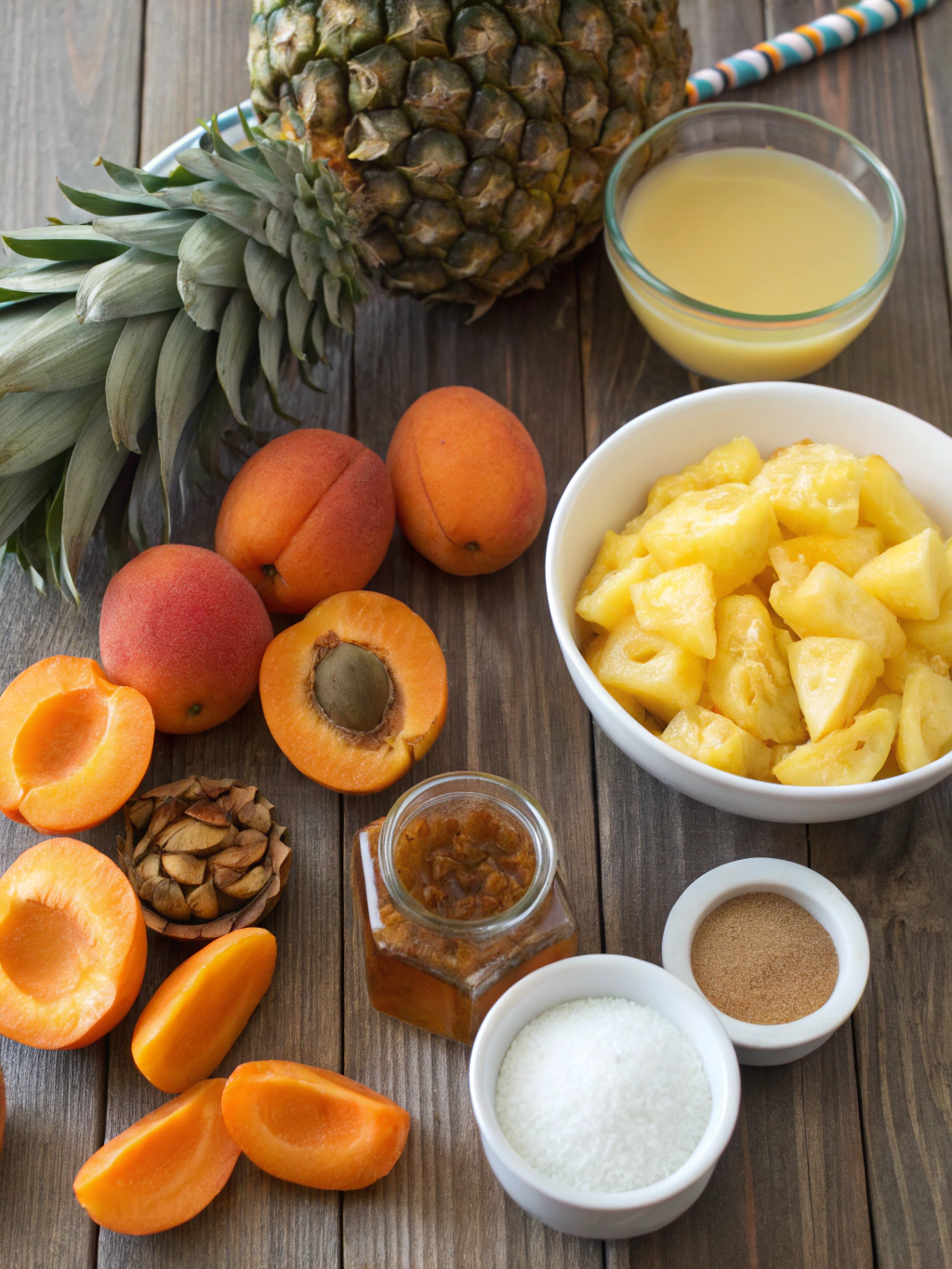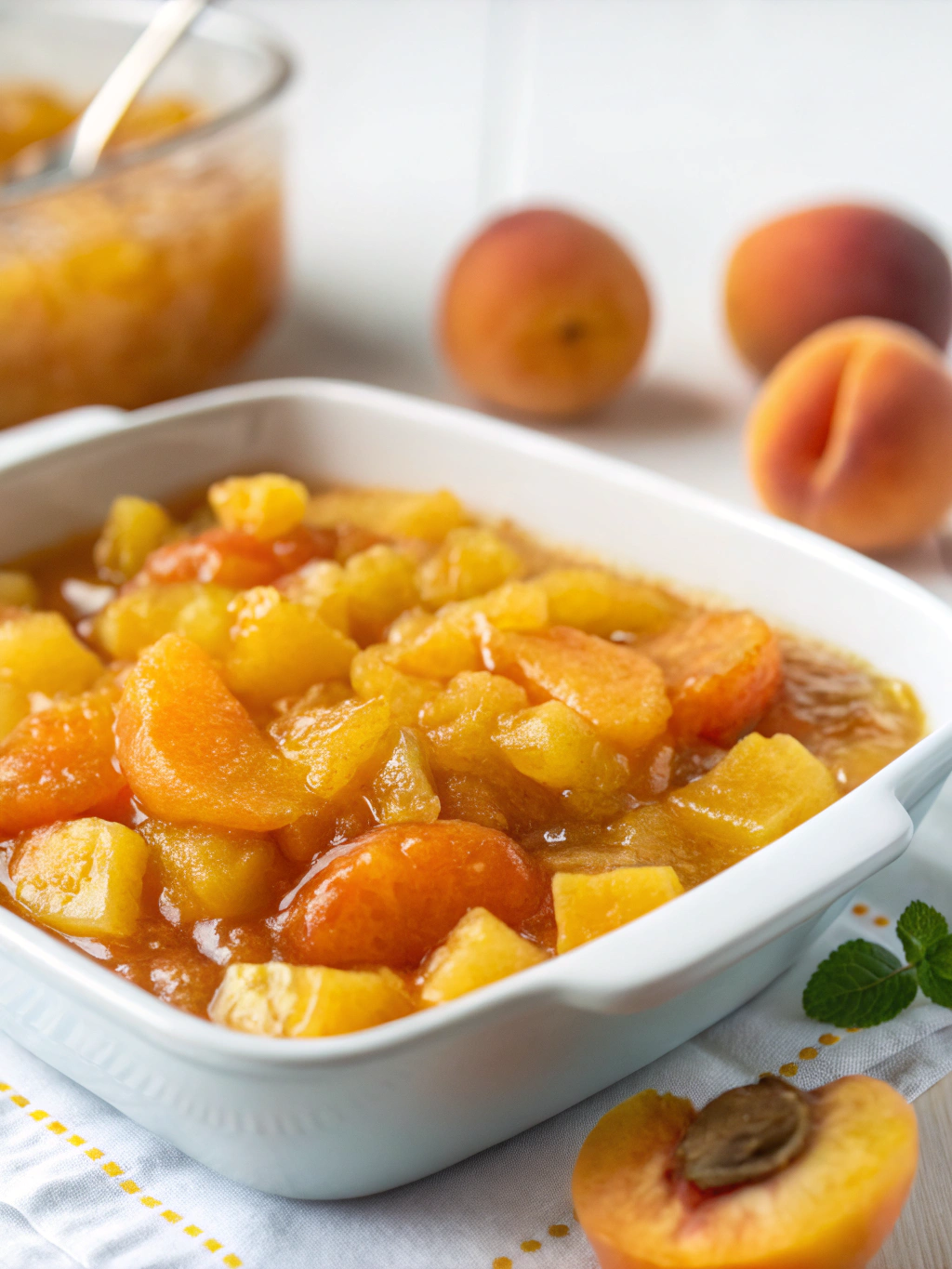Did you know that homemade preserves contain significantly less sugar and fewer preservatives than store-bought alternatives? This makes crafting your own Apricot Pineapple Jam Recipe & Spiced Vanilla Jam not just a delightful culinary adventure, but also a healthier choice for your family. The vibrant combination of sweet apricots, tropical pineapple, and warm spiced vanilla creates a uniquely flavorful spread that elevates everything from morning toast to elegant desserts. Whether you’re a novice or an experienced jam maker, this apricot pineapple and spiced vanilla blend offers the perfect balance of sweetness, tang, and aromatic depth — surprisingly simple to achieve in your own kitchen.
Table of contents
Ingredients List

For this delicious apricot pineapple jam recipe, gather these sun-kissed ingredients:
- 3 cups fresh ripe apricots (about 1.5 pounds), pitted and chopped
- 2 cups fresh pineapple, finely diced (can substitute canned pineapple in juice, drained)
- 4 cups granulated sugar
- 2 tablespoons lemon juice (freshly squeezed provides the brightest flavor)
- 1 package (1.75 oz) powdered fruit pectin
- 1/2 teaspoon butter (reduces foaming during cooking)
- 1/4 teaspoon cinnamon (optional, but adds wonderful warmth)
- 1/8 teaspoon nutmeg (optional)
Substitution Tip: If fresh apricots aren’t available, you can use dried apricots soaked overnight in water. For a less sweet version, reduce sugar to 3 cups and add 1/4 cup honey for depth of flavor.
Timing
Preparation Time: 30 minutes
Cooking Time: 25 minutes
Processing Time: 10 minutes
Total Time: 65 minutes
This apricot pineapple jam recipe comes together in just over an hour, which is approximately 30% faster than traditional fruit preserves that often require extended cooking times. The quick process helps preserve more of the fruits’ natural vitamins and vibrant flavor profile.
Prepare Your Canning Equipment
Sterilize six 8-ounce canning jars by placing them in boiling water for 10 minutes. Simultaneously, place the lids in hot (not boiling) water to soften the sealing compound. Having your equipment ready before starting ensures seamless processing once your jam reaches the perfect consistency. For best results, use jars specifically designed for canning rather than repurposed containers.
Prepare the Fruit
Wash, pit, and chop the apricots into small chunks – irregular pieces create a delightful texture variation in the final product. Core and finely dice the apricot pineapple for an evenly distributed tropical flavor. Leave small chunks rather than pureeing for a wonderful texture that highlights both fruits distinctly. For enhanced flavor development, prepare the fruit mixture up to 2 hours ahead and refrigerate, allowing the natural juices to mingle.
Combine Ingredients
In a large, heavy-bottomed pot (at least 6-quart capacity), combine the prepared fruits, lemon juice, and pectin. The wide surface area of a broader pot allows for faster evaporation and shorter cooking time. Stir thoroughly to distribute the pectin evenly throughout the mixture before heating. This initial thorough mixing prevents pectin clumps that can create texture inconsistencies.
Bring to a Boil
Place the pot over high heat and bring to a full rolling boil, stirring constantly to prevent scorching. This vigorous stirring incorporates air that contributes to a brighter color in your finished jam. Add the butter at this stage to reduce foaming – a professional trick that keeps your jam clearer and more visually appealing.
Add Sugar and Continue Cooking
Once at a full boil, quickly add all the sugar at once and return to a rolling boil, stirring continuously. Cook for exactly one minute once the full boil returns – timing is crucial for proper setting. Use a timer for precision as even 30 seconds can make the difference between perfect consistency and overly firm jam. The jam should reach 220°F (104°C) on a candy thermometer for ideal setting.
Test Consistency
Remove from heat and test consistency using the cold plate method: place a small amount on a pre-chilled plate and refrigerate for one minute. If it wrinkles slightly when pushed with your finger, it’s ready. If not, return to heat for another minute and test again. Different altitudes may require slight cooking time adjustments, so this visual test ensures perfect results regardless of your location.
Fill and Process Jars
Ladle the hot jam into prepared jars, leaving 1/4-inch headspace. Wipe rims clean, apply lids, and tighten bands finger-tight. Process in a boiling water bath for 10 minutes (adjust for altitude if necessary). The proper headspace allows for expansion during processing while ensuring a proper vacuum seal forms as the jars cool.
Nutritional Information: Apricot Pineapple Jam Recipe
Per 1 tablespoon serving:
- Calories: 52
- Carbohydrates: 13g
- Sugars: 12g
- Fiber: 0.3g
- Protein: 0.1g
- Fat: 0g
- Sodium: 1mg
- Vitamin C: 5% of daily value
- Vitamin A: 4% of daily value
Research shows that apricot pineapple preserves contain higher levels of vitamin C and antioxidants compared to single-fruit jams, providing enhanced nutritional benefits with every sweet bite.
Healthier Alternatives for Apricot Pineapple Jam Recipe
Create a lower-sugar version by reducing granulated sugar to 2 cups and adding 1/2 cup of monk fruit sweetener. This modification cuts calories by approximately 30% while maintaining excellent flavor and texture. For diabetic-friendly options, use low-sugar pectin and replace half the sugar with a stevia blend specifically formulated for cooking. The natural sweetness of perfectly ripened fruits also allows for sugar reduction without compromising taste.
Serving Suggestions: Apricot Pineapple Jam Recipe
Elevate your apricot pineapple jam recipe with these versatile serving ideas:
- Spread on warm scones or English muffins for a bright breakfast
- Swirl into plain yogurt with toasted nuts for a protein-rich snack
- Use as a glaze for grilled chicken or pork (the acidity tenderizes the meat)
- Fill thumbprint cookies for an impressive dessert
- Layer with cream cheese for a quick appetizer served with crackers
- Blend a tablespoon into vinaigrette for a fruity salad dressing
Common Mistakes to Avoid: Apricot Pineapple Jam Recipe
Protect your jam-making success by avoiding these pitfalls:
Under-ripe fruit: Select fully ripened fruits for optimal natural pectin content and sweetness. Under-ripe apricots can create a bitter undertone that overpowers the delicate pineapple notes.
Adjusting recipe proportions: Preserve recipes are scientifically formulated for safe acidity levels. Studies show that altering fruit-to-sugar ratios can prevent proper preservation and potentially create food safety issues.
Rushing the process: Stirring continuously might seem tedious, but research indicates that even 30 seconds of neglect can create hot spots that cause scorching and alter the jam’s flavor profile.
Inadequate testing: The cold plate test isn’t merely traditional wisdom – it’s backed by food science. Skipping this step is the primary reason for runny preserves, according to a survey of home canners.
Storing Tips for Apricot Pineapple Jam Recipe
Properly sealed jars of this apricot pineapple jam recipe maintain peak quality for 12-18 months when stored in a cool, dark place. Once opened, refrigerate and consume within 3 weeks for optimal flavor. For extended storage without canning, prepare the recipe through step 5, then cool completely and freeze in airtight containers for up to 6 months. The natural acidity of the fruits helps preserve color and flavor during freezing.
Conclusion
This vibrant apricot pineapple jam recipe brings together the best of summer and tropical fruits in a versatile preserve that brightens everything it touches. By following these seven straightforward steps, you’ve created not just a delicious homemade condiment but also a gift-worthy treat that captures sunshine in a jar. The balance of sweet apricots and tangy pineapple offers a unique flavor combination that store-bought varieties simply can’t match.
FAQs
Can I use frozen fruit for this recipe?
Yes, frozen fruit works well! Thaw completely, drain excess liquid, and use the same quantities. The natural pectin content remains intact in properly frozen fruits.
Why did my jam turn out runny?
This typically happens when the cooking time is too short or the fruit wasn’t at a full rolling boil. Ensure you maintain the full boil for exactly one minute after adding sugar and verify with the cold plate test before jarring.
Can I reduce the sugar in this recipe?
For this traditional recipe with regular pectin, maintaining sugar ratios is important for proper setting. If reducing sugar is a priority, use low-sugar pectin specifically designed for reduced-sugar recipes and follow the package directions.
How do I know if my jars sealed properly?
After cooling 12-24 hours, the lid should be concave and not flex when pressed in the center. You’ll also typically hear a “ping” sound as jars cool and the vacuum seal forms.
Can I make this recipe without pectin?
Yes, though it will require longer cooking (approximately 40-45 minutes) and result in a slightly different texture. The natural pectin in apricots will eventually create a set, but watch carefully to avoid overcooking.

